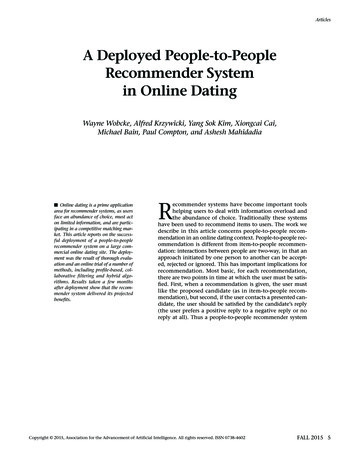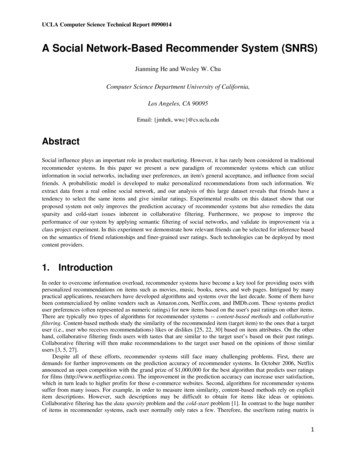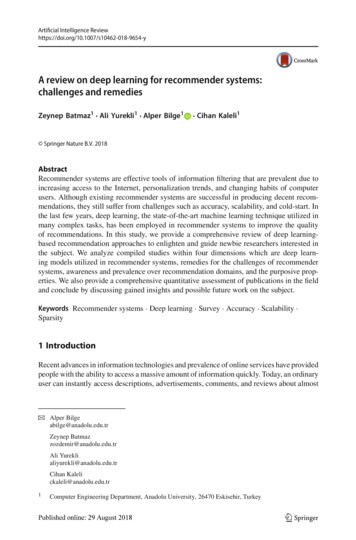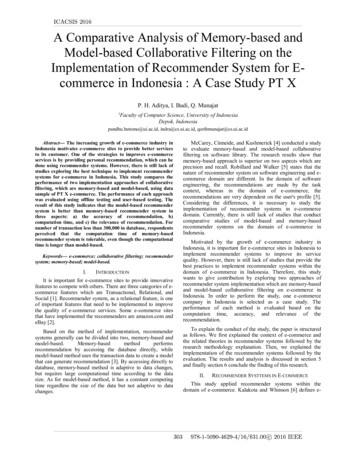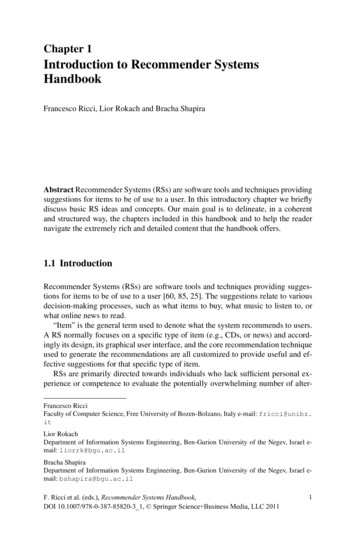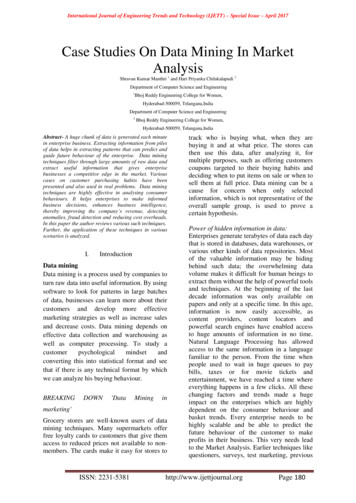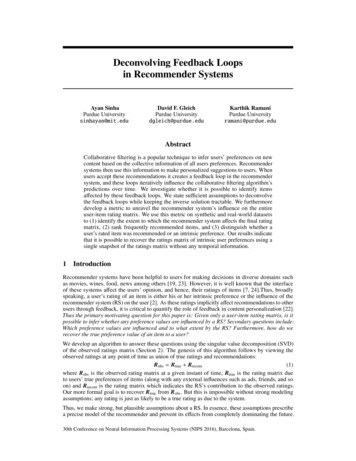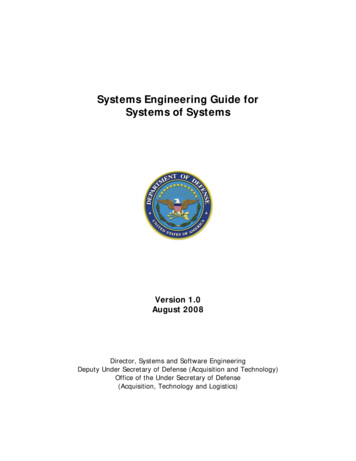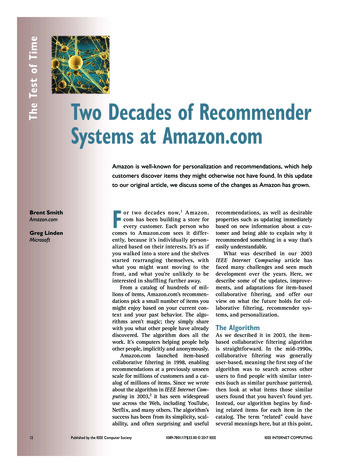
Transcription
The Test of TimeTwo Decades of RecommenderSystems at Amazon.comAmazon is well-known for personalization and recommendations, which helpcustomers discover items they might otherwise not have found. In this updateto our original article, we discuss some of the changes as Amazon has grown.Brent SmithAmazon.comGreg LindenMicrosoft12For t wo decades now,1 Amazon.com has been building a store forevery customer. Each person whocomes to Amazon.com sees it differently, because it’s individually personalized based on their interests. It’s as ifyou walked into a store and the shelvesstarted rearranging themselves, withwhat you might want moving to thefront, and what you’re unlikely to beinterested in shuffling further away.From a catalog of hundreds of millions of items, Amazon.com’s recommendations pick a small number of items youmight enjoy based on your current context and your past behavior. The algorithms aren’t magic; they simply sharewith you what other people have alreadydiscovered. The algorithm does all thework. It’s computers helping people helpother people, implicitly and anonymously.Amazon.com launched item-basedcollaborative filtering in 1998, enablingrecommendations at a previously unseenscale for millions of customers and a catalog of millions of items. Since we wroteabout the algorithm in IEEE Internet Computing in 2003,2 it has seen widespreaduse across the Web, including YouTube,Netflix, and many others. The algorithm’ssuccess has been from its simplicity, scalability, and often surprising and usefulPublished by the IEEE Computer Societyrecommendations, as well as desirableproperties such as updating immediatelybased on new information about a customer and being able to explain why itrecommended something in a way that’seasily understandable.What was described in our 2003IEEE Internet Computing article hasfaced many challenges and seen muchdevelopment over the years. Here, wedescribe some of the updates, improvements, and adaptations for item-basedcollaborative filtering, and offer ourview on what the future holds for collaborative filtering, recommender systems, and personalization.The AlgorithmAs we described it in 2003, the itembased collaborative filtering algorithmis straightforward. In the mid-1990s,collaborative filtering was generallyuser-based, meaning the first step of thealgorithm was to search across otherusers to find people with similar interests (such as similar purchase patterns),then look at what items those similarusers found that you haven’t found yet.Instead, our algorithm begins by finding related items for each item in thecatalog. The term “related” could haveseveral meanings here, but at this point,1089-7801/17/ 33.00 2017 IEEE IEEE INTERNET COMPUTING
Two Decades of Recommender Systems at Amazon.comStanding the Test of TimeAs part of recognizing IEEE Internet Computing for its 20years in publication, I recommended to the editorialboard that we pick one of our magazine articles that, over thepast 20 years, has withstood the “test of time.” In selecting anarticle, we evaluated the ideas in more than 20 candidate articles that reported on “evergreen” research areas over the pasttwo decades and then assessed these articles based on downloads from IEEE Xplore, citations, and mentions of the work inpopular press. This information was presented to a committee consisting of previous Editors in Chief for the magazine. Iwould like to thank the selection committee from the editorialboard — led by Arun Iyengar, and including Fred Douglis, Robert Filman, Michael Huhns, Charles Petrie, Michael Rabinovich,and Munindar Singh. This committee deliberated on the topthree articles by evaluating each work’s previous importancewithin the context of its sustained importance in the future.It’s my pleasure to recognize the committee’s official “Testof Time” winner: an industry article titled “Amazon.com Recommendations: Item-to-Item Collaborative Filtering” by Greg Linden,let’s loosely define it as “people who buy oneitem are unusually likely to buy the other.” So,for every item i1, we want every item i2 that waspurchased with unusually high frequency bypeople who bought i1.Once this related items table is built, we cangenerate recommendations quickly as a seriesof lookups. For each item that’s part of this customer’s current context and previous interests,we look up the related items, combine them toyield the most likely items of interest, filter outitems already seen or purchased, and then weare left with the items to recommend.This algorithm has many advantages overthe older user-based collaborative filtering.Most importantly, the majority of the computation is done offline — a batch build of the relateditems — and the computation of the recommendations can be done in real time as a series oflookups. The recommendations are high qualityand useful, especially given enough data, andremain competitive in perceived quality evenwith the newer algorithms created over the lasttwo decades. The algorithm scales to hundredsof millions of users and tens of millions ofitems without sampling or other techniques thatcan reduce the quality of the recommendations.The algorithm updates immediately on newinformation about a person’s interests. Finally,the recommendations can be explained in anmay/june 2017 Brent Smith, and Jeremy York, from the January/February 2003issue of IC (see doi:10.1109/MIC.2003.1167344). Fourteen yearsafter the publication of this article, it shows 125 downloads fromIEEE Xplore in one month, with more than 12,754 downloads sinceJanuary 2011. The article currently shows 4,258 citations in GoogleScholar. I’m delighted that the selection committee recommendedan industry article, as it aligns with the magazine’s focus of accessibility in academic, research, and industrial populations.In addition to recognizing the article, we asked the authorsto create this retrospective piece discussing research andinsights that have transpired since publishing their winning“Test of Time” article, while projecting into the future.Going forward, the magazine hopes to celebrate a “Test ofTime” article every 2–3 years. I hope that you enjoy this retrospective article, and please take a moment to congratulateGreg Linden, Brent Smith, and Jeremy York.— M. Brian BlakeEditor-in-Chief, IEEE Internet ComputingProvost and Distinguished Professor, Drexel Universityintuitive way as arising from a list of items thecustomer remembers purchasing.In 2003: Amazon.com, Netflix,YouTube, and MoreBy the time we published in IEEE in 2003, itembased collaborative filtering was widely deployedacross Amazon.com. The homepage prominentlyfeatured recommendations based on your pastpurchases and items browsed in the store. Searchresult pages recommended items related to yoursearch. The shopping cart recommended otheritems to add to your cart, perhaps impulse buysto bundle in at the last minute, or perhaps complements to what you were already considering.At the end of your order, more recommendationsappeared, suggesting items to order later. Usinge-mails, browse pages, product detail pages, andmore, many pages on Amazon.com had at leastsome recommended content, starting to approacha store for every customer.Others have reported using the algorithm,too. In 2010, YouTube reported using it for recommending videos.3 Many open source andthird-party vendors included the algorithm, andit showed up widely in online retail, travel, news,advertising, and more. In the years following,the recommendations were used so extensivelyby Amazon.com that a Microsoft Research reportestimated 30 percent of Amazon.com’s page13
The Test of TimeA Present-Day Perspective on Recommendation and Collaborative FilteringAs a PhD student who uses collaborative filtering in mywork to introduce customized recommendation techniques (and collaborative filtering) that select “workers” forcrowdsourcing,1,2 the Test of Time article is particularly meaningful to me. Collaborative filtering is a technique used to personalize the experience of users through recommendationstailored to the users’ interests, leveraging the experiences ofother users with similar profiles. Traditionally, the techniqueis used in e-commerce platforms to drive sales by convertingtargeted suggestions to purchases. 3 The technique has rendered more favorable results than blanket advertisement, andis more purposeful toward customizing the experience of individual users. Despite this success, two primary challenges havesurfaced: these are concerns related to real-time scalability andrecommendation quality. These concerns directly impact theusers’ individual experiences and, by induction, the success ofthe platforms using the technique.The first concern of scalability is directly affected by today’sinexpensive and evolving storage and computing capabilities;these have led to overwhelming data generation and collection.Unfortunately, algorithms — including traditional collaborativefiltering — haven’t evolved in capacity to handle this new volume of data in real time or in an online modality. To addressthe issue of scalability, a variety of techniques are employedto reduce the dataset in a structured manner. Some of theseapproaches include sampling users, data partitioning driven bythe classification of items, and omitting high- or low-frequencyitems to bubble others to the top of the recommended list.These approaches, while seeking to remedy the issue in scalability, affect the quality in recommendations; this is a directimpact to the second concern.Given these concerns, it was incumbent on the researchcommunity and practitioners to devise an approach that gainsthe benefits of scalability without sacrificing recommendationquality. The most successfully employed approach has comein the form of item-based collaborative filtering. Its continuedsuccess is evident in applications such as the major large-scalee-commerce platform, Amazon.com. It scopes recommendations via the user’s purchased or rated items, pairing them tosimilar items against established metrics, and finally composing a list of similar items as recommendations. As opposed todataset-reduction techniques employed through user-centricmeans, this approach is item-centric, which drastically reducesthe data space for evaluation. As outlined in IEEE Internet Computing’s Test of Time article4 and other closely related work, 5this data-space reduction is potentially up to three orders ofmagnitude of its original size. Being item-centric, it overcomesthe issue with sparsity in user data in traditional approaches(such approaches contribute largely to unnecessary evaluation). It also overcomes the issue of the density in frequentusers who have large portions of data associated with theirprofiles.Item-based collaborative filtering still requires offlineprocessing to pair similar items. By preprocessing this information offline, recommendations in the list produced fromitem-based collaborative filtering can occur in real time in anonline modality. This allows for easy, quick, more personalizedrecommendation for the user. The similar items list is a sleeksubset of items targeted to the user’s purchasing or rating history, as opposed to that of others in the entire dataset. It alsoovercomes challenges with newer and less-frequent users withsparse history, because the similar items list focuses on theuser’s history as opposed to the history of other users. Thistechnique is more efficient, yet it hasn’t had any adverse effectson the quality of recommendations; as such, it continues to bethe technique of choice for real-time, online collaborative filtering and recommendations.— Julian JarrettPhD Student, Computer Science, Drexel UniversityReferences1. J. Jarrett and M.B. Blake, “Using Collaborative Filtering to AutomateWorker-Job Recommendations for Crowdsourcing Services,” Proc. 2016IEEE Int’l Conf. Web Services, 2016, pp. 641–645.2. J. Jarrett et al., “Self-Generating a Labor Force for Crowdsourcing: IsWorker Confidence a Predictor of Quality?” Proc. 2015 3rd IEEE Workshopon Hot Topics in Web Systems and Technologies, 2015, pp. 85–90.3. J.L. Herlocker, et al., “Evaluating Collaborative Filtering Recommender Systems,” ACM Trans. Information Systems, vol. 22, no. 1, 2004, pp. 5–53.4. G. Linden, B. Smith, and J. York, “Amazon.com Recommendations: Itemto-Item Collaborative Filtering,” IEEE Internet Computing, vol. 7, no. 1, 2003,pp. 76–80.5. B. Sarwar et al., “Item-Based Collaborative Filtering RecommendationAlgorithms,” Proc. 10th Int’l Conf. World Wide Web, 2001, pp. 285–295.views were from recommendations.4 Similarly,Netflix used recommender systems so extensively that their Chief Product Officer, Neil Hunt,indicated that more than 80 percent of movieswatched on Netflix came through recommendations,5 and placed the value of Netflix recommendations at more than US 1 billion per year.14www.computer.org/internet/ When we originally developed item-basedcollaborative filtering, Amazon.com was primarily a bookstore. Since then, Amazon.com’ssales have grown more than a hundred-fold andhave expanded beyond books to be dominatedby non-media items, from laptop computers towomen’s dresses. This growth challenged manyIEEE INTERNET COMPUTING
Two Decades of Recommender Systems at Amazon.comEXY c X c 1 c X k 0 c k 1 c c X k 1 ( 1)k 1 ( kc )PYkc X k 1 ( kc )( PY )k 1 1 ( kc )( PY )k ( 1)k 1 ( kc )PYkc X 1 (1 P ) c Y ( 1)k 1 ( kc )PYk(since( kc ) 0 for k c )(Fubini's theorem)k 1 c X αk ( X )PYkk 1where αk ( X ) ( 1)k 1 ( kc ).c XFigure 1. The derivation of the expected number of customers who bought both items X and Y,accounting for multiple opportunities for each X-buyer to buy Y.assumptions in our original algorithms, requiring adaptation to a new and changing landscape. Through experience, we also found waysto refine the algorithm to produce more relevantrecommendations for the many new applications of it.Defining “Related” ItemsThe quality of recommendations depends heavilyon what we mean by “related.” For example, whatdo we mean by “unusually likely” to buy itemY given that you bought X? When we observethat customers have bought both X and Y, wemight wonder how many X-buyers would haverandomly bought Y if the two items were unrelated. A recommender system is ultimately anapplication of statistics. Human behavior is noisy,and the challenge is to discover useful patternsamong the randomness.A natural way to estimate the number of customers NXY who have bought both X and Y wouldbe to assume X-buyers had the same probability, P(Y) Y buyers / all buyers , of buying Y asthe general population and use X buyers * P(Y)as our estimate, EXY, of the expected number ofcustomers who bought both X and Y. Our 2003article, and much of our work before 2003, used acalculation similar to this.However, it’s a curious fact that, for almostany two items X and Y, customers who boughtX will be much more likely to buy Y than themay/june 2017 general population. How can that be? Imagine aheavy buyer — someone who has bought everyitem in the catalog. When we look for all the customers who have bought X, this customer is guaranteed to be selected. Similarly, a customer whohas made 1,000 purchases will be about 50 timesas likely to be selected as someone with 20 purchases; sampling a random purchase doesn’t givea uniform probability of selecting customers. So,we have a biased sample. For any item X, customers who bought X will be likely to have boughtmore than the general population.This non-uniform distribution of customerpurchase histories means we can’t ignore whobought X when we’re trying to estimate howmany X-buyers we would expect to randomlybuy Y. We found it useful to model customers ashaving many chances to buy Y.6 For example,for a customer with 20 purchases, we take eachof these 20 purchases as an independent opportunity to have purchased Y.More formally, for a given customer c who purchased X (denoted by c X), we can estimate c’sprobability of buying Y as 1 - (1 - PY ) c , where c represents the number of non-X purchases madeby c and PY Y purchases / all purchases or theprobability that any randomly selected purchaseis Y. Then, we can calculate the expected number of Y-buyers among the X-buyers by summingover all X-buyers and using a binomial expansion(see Figure 1).15
The Test of TimeWe can write EXY as a polynomial in PY withcoefficients that depend purely on X. In practice, PY ’s are small, so close approximations canbe made with bounded k. In addition, PY anda k(X) can be precomputed for all items, whichthen allows EXY to be approximated for any pairof items with a simple combination of precomputed values.With a robust method of computing EXY, wecan use it to evaluate whether NXY, the observednumber of customers who bought both X andY, is higher or lower than randomly would beexpected. For example, NXY - EXY gives anestimate of the number of non-random cooccurrences, and [NXY - EXY ]/EXY gives thepercent difference from the expected randomco-occurrence. These are two examples of creating a similarity score S(X, Y) as a function ofthe observed and expected number of customerswho purchased both X and Y. The first, NXY EXY, will be biased toward popular Y’s such asthe first Harry Potter book, so the recommendations might be perceived as too obvious or irrelevant. The second, [NXY - EXY ]/EXY, makes it tooeasy for low-selling items to have high scores,so the recommendations might be perceived asobscure and random, especially because of thelarge number of unpopular items. Relatednessscores need to strike a balance between popularity on one end and the power law distributionof unpopular items on the other. The chi-squarescore, [ N XY EXY ] / EXY , is an example thatstrikes such a balance.There are several other choices and parameters that could be considered in a relatednessscore and in creating recommendations fromrelated items. Our experience is that there is noone score that works best in all settings. Ultimately, perceived quality is what recommendations are judged on; recommendations areuseful when people find them useful.Machine learning and controlled online experimentation can learn what customers actuallyprefer, picking the best parameters for the specificuse of the recommendations. Not only can wemeasure which recommendations are effective,but we can also feed information about whichrecommendations people liked, clicked on, andbought back into our algorithms, learning whathelps customers the most.7For example, compatibility is an importantrelationship. We might observe that customerswho buy a particular digital camera are unusu16www.computer.org/internet/ ally likely to buy a certain memory card, butthis doesn’t guarantee that the memory cardworks with the camera. Customers buy memorycards for many reasons and the observed correlation might be a random occurrence. Indeed,there are hundreds of thousands of memorycards in Amazon.com’s catalog, so many ofthem are randomly correlated with the camera. Many e-commerce sites use a hand-curatedknowledge base of compatibility, which isexpensive and error-prone to maintain, especially at Amazon.com’s scale. We found that,given enough data and a robust metric for therelatedness of items, compatibility can emergefrom people’s behavior, with the false signalsfailing away and the truly appropriate itemssurfacing.Curiously, we found that the meaning ofrelated items also can be emergent, arising fromthe data, and discovered by customers themselves. Consider the items people look at versusthe items they purchase. For books, music, andother low-cost items, people tend to look at andpurchase the same thing. For many expensiveitems, and especially for non-media items, whatpeople view and what they purchase can beradically different. For example, people tend tolook at many televisions, but only purchase one.What they look at around the time of lookingat that television will tend to be other televisions. What they purchase around the time theybought a television tends to be complementsthat enhance the experience after buying thatparticular television, such as a Blu-ray playerand a wall mount.The Importance of TimeUnderstanding the role of time is important forimproving the quality of recommendations. Forexample, when computing the related items table,how related a purchase is to another purchasedepends heavily on their proximity in time. Ifa customer buys a book five months after buying another book, this is weaker evidence forthe books being related than if the customer hadpurchased them on the same day. Time directionality also can be helpful. For example, thefact that customers tend to buy a memory cardafter buying a camera, rather than the other wayaround, might be a good hint that we shouldn’trecommend the camera when someone buysthe memory card. Sometimes, items are boughtsequentially, such as a book, movie, or TV series,IEEE INTERNET COMPUTING
Two Decades of Recommender Systems at Amazon.comand recommendations should be for what youwant to do next.Amazon.com’s catalog is continually changing through time. Every day, thousands of newitems arrive and many others fade into obscurity and obsolescence. This cycle is especiallypronounced in some categories. For example,apparel has seasonal fashions, and consumerelectronics has rapid technological innovation.New items can be at a disadvantage, becausethey don’t have enough data yet to have a strongcorrelation with other items. This is referred toas the cold-start problem, and often requires anexplore/exploit process to give items that havenot yet had much opportunity to be purchasedan opportunity to be shown. Perishable itemssuch as news or social media posts representa particularly challenging form of cold start,often requiring blending data from contentbased algorithms (using subject, topic, and text)with behavior-based algorithms (using purchases, views, or ratings).Customers also have a lifecycle and experience their own cold-start problem. Knowingwhat to recommend when we have very limitedinformation about a new customer’s interestshas long been an issue. When to make use oflimited information and when to play it safewith generally popular items is a subtle transition that’s difficult to get correct.Even for established customers, modelingtime correctly has a large impact on the quality of recommendations. As they age, previouspurchases become less relevant to the customer’s current interests. This is complicated by thefact that this relevance can attenuate at different rates for different types of items. For example, some purchases — such as a manual onsailing heavy seas — likely indicate a durablelong-term interest. Others such as a dishwasherrepair kit might not be relevant after this weekend’s project. There are even some purchasessuch as baby rattles where the recommendations have to change over a long period of time;four years later, we should recommend balancebikes and board books rather than baby bottlesand teethers. And some items, such as books,are usually only bought once; others, such astoothpaste, are bought again and again witha fairly predictable lapse of time between thepurchases.The quality of recommendations we canmake depends not only on the timing of pastmay/june 2017 purchases, but what was purchased. We foundthat a single book purchase can say a lot abouta customer’s interests, letting us recommenddozens of highly relevant items. But, manypurchases in non-media categories tell us little about the customer. What insights can begleaned from the purchase of a stapler? Whatsurprising and insightful recommendations canbe made from buying a pair of socks? Recommending tape dispensers or more underwearmight be helpful in the moment, but leads touninspiring recommendations in the longerterm. Thus, we had to develop techniques forlearning which purchases lead to useful recommendations and when some should be ignored.Finally, the importance of diversity in recommendations is well known; sometimes it’sbetter to give a variety of related items ratherthan a narrowly targeted list. The breadth ofAmazon.com’s massive catalog with its manytypes of products offers a unique challenge notseen in single-product category stores such asbookstores. For example, recommending morebooks to a heavy reader might lead to a sale,but people might benefit most long term by discovering items they have never even consideredbefore in another product line. Immediate intentis a factor in diversity as well. When someone isclearly seeking something specific, recommendations should be narrow to help them quicklyfind what they need. But when intent is unclearor uncertain, discovery and serendipity shouldbe the goal. Finding the right balance in thediversity of recommendations requires experimentation along with a willingness to optimizefor the long term.The Future: RecommendationsEverywhereWhat does the future hold for recommendations?We believe there’s more opportunity ahead of usthan behind us. We imagine intelligent interactive services where shopping is as easy as aconversation.This moves beyond the current paradigm oftyping search keywords in a box and navigating awebsite. Instead, discovery should be like talkingwith a friend who knows you, knows what youlike, works with you at every step, and anticipatesyour needs.This is a vision where intelligence is everywhere. Every interaction should reflect who youare and what you like, and help you find what17
The Test of Timeother people like you have already discovered.It should feel hollow and pathetic when you seesomething that’s obviously not you; do you notknow me by now?Getting to this point requires a new way ofthinking about recommendations. There shouldn’tbe recommendation features and recommendation engines. Instead, understanding you, others, and what’s available should be part of everyinteraction.Recommendations and personalization live inthe sea of data we all create as we move throughthe world, including what we find, what we discover, and what we love. We’re convinced thefuture of recommendations will further build onintelligent computer algorithms leveraging collective human intelligence. The future will continueto be computers helping people help other people.Nearly two decades ago, Amazon.com launchedrecommendations to millions of customersover millions of items, helping people discoverwhat they might not have found on their own.Since then, the original algorithm has spreadover most of the Web, been tweaked to help people find videos to watch or news to read, beenchallenged by other algorithms and other techniques, and been adapted to improve diversityand discovery, recency, time-sensitive or sequential items, and many other problems. Because ofits simplicity, scalability, explainability, adaptability, and relatively high-quality recommendations, item-based collaborative filtering remainsone of the most popular recommendation algorithms today.Yet the field remains wide open. An experience for every customer is a vision none havefully realized. Much opportunity remains to addintelligence and personalization to every part ofevery system, creating experiences that seem likea friend that knows you, what you like, and whatothers like, and understands what options are outthere for you. Recommendations are discovery,offering surprise and delight with what they helpuncover for you. Every interaction should be arecommendation. 2. G. Linden, B. Smith, and J. York, “Amazon.com Recommendations: Item-to-Item Collaborative Filtering,”IEEE Internet Computing, vol. 7, no. 1, 2003, pp. 76–80.3. J. Davidson et al., “The YouTube Video RecommendationSystem,” Proc. 4th ACM Conf. Recommender Systems,2010, pp. 293–296.4. A. Sharma, J.M. Hofman, D.J. Watts, “Estimatingthe Causal Impact of Recommendation Systems fromObservational Data,” Proc. 16th ACM Conf. Economicsand Computation, 2015, pp. 453–470.5. C.A. Gomez-Uribe and N. Hunt, “The Netflix RecommenderSystem: Algorithms, Business Value, and Innovation,”ACM Trans. Management Information Systems, vol. 6, no.4, 2016, pp. 1–19.6. B. Smith, R. Whitman, and G. Chanda, System forDetecting Probabilistic Associations between Items, USPatent 8,239,287, to Amazon.com, Patent and Trademark Office, 2012.7. K. Chakrabarti and B. Smith, Method and System forAssociating Feedback with Recommendation Rules, USPatent 8,090,621, to Amazon.com, Patent and Trademark Office, 2012.Brent Smith has worked on personalization and recommendations at Amazon.com for 17 years, leading teamsthat work on fast-paced customer-facing innovation.Smith has a BS in mathematics from the Universityof California, San Diego, and an MS in mathematicsfrom the University of Washington. Contact him atsmithbr@amazon.com.Greg Linden is a data scientist at Microsoft (previously atAmazon.com, Google, and several startups). Much ofhis previous work was in recommendations, personalization, artificial intelligence, search, and advertising. Linden has an MS in computer science from theUniversity of Washington and an MBA from StanfordUniversity. Contact him at glinden@gmail.com.References1. G.D. Linden, J.A. Jacobi, and E.A. Benson, Collaborative Recommendations Using Item-to-Item SimilarityMappings, US Patent 6,266,649, to Amazon.com, Patent and Trademark Office, 2001 (filed 1998).18www.computer.org/internet/ Read your subscriptions throughthe myCS publications portal athttp://mycs.computer.org.IEEE INTERNET COMPUTING
Netflix used recommender systems so exten-sively that their Chief Product Officer, Neil Hunt, indicated that more than 80 percent of movies watched on Netflix came through recommenda-tions,5 and placed the value of Netflix recom-mendations at more than US 1 billion per year. When we originally developed item-based

